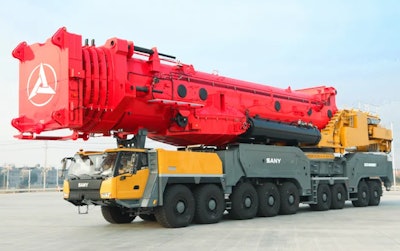
Editor's note, December 11, 2024: Sany America confirmed to Equipment World that the SAC40000T will not be available in the U.S. "due to restriction of local law and regulations."
Billed as the world’s largest all-terrain crane, Sany’s SAC40000T is optimized for wind turbine installation and was designed to have the largest lifting capacity on the fewest axles.
 Safety features include intelligent boom status monitoring systems and real-time side-bending angle monitoring.Sany
Safety features include intelligent boom status monitoring systems and real-time side-bending angle monitoring.Sany
The 9-axle, 4,000-metric-ton unit with a 72-foot chassis – the smallest in its class – was delivered to the Chinese hoisting company Zhejiang Hesheng Hoisting Engineering Co., Ltd. on October 31. It features a 266-foot full-extension boom, 407-foot jib and 350-metric-ton counterweights with a max lifting height of 656 feet.
Safety features include intelligent boom status monitoring and active control systems, real-time side-bending angle monitoring and a new signal receiver that boosts signal stability by 20%.
The company said the SAC40000T achieves “the most compact and smallest turning radius in the same tonnage class” with a 53-foot turning radius.
The entire unit can achieve single-side superlift setup and disassembly in under an hour.
Other features on the SAC40000T include:
- Gradability up to 18%
- The ability to travel on-site with superlift structure
- Under 70 minutes reeving time
“We know there’s a growing need for powerful, precise equipment to drive clean energy forward,” said the SAC40000T’s project manager. “Current 2000t class can handle 7-8MW turbines. But 10-13MW turbines over the next 5-10 years? That’s why we bring 4,000t AT to the table. Prioritizing a compact, powerful design with fewer axles, we’ve enhanced its flexibility and ease of travel on rugged, mountainous terrain.”











